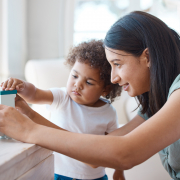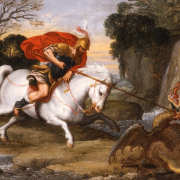Playful Parenting: Bluey as a Model of Child-Centered Play by Dr. Emily Dowdell
You may or may not yet be aware of Bluey, a television show designed for preschool children. Bluey is an animated series about the playful adventures of a family of blue heeler dogs. The show premiered in Australia in October 2018 and in our home in the summer of 2020, and we absolutely love it.
In graduate school, I learned about the integral role of play in how children process emotions and work through the many challenges they face. Children need play. It is often their only outlet to express the feelings they cannot put into words. Play helps children learn how to share their inner life, regulate their emotions, and heal their wounds.
In an episode called Daddy Putdown, Chili (Mum) goes to a baby shower and leaves the girls in Bandit (Dad)’s capable hands. Bluey is stuck on missing her mum. Bandit pulls out all the games in an effort to distract Bluey from her feelings. The games only take her mind off them for a little while. Seeing that Bluey is still struggling, Bandit gets down on her level:
Bluey: Please, can you tell her to come back?
Bandit: Okay. [dialing] It’s just that she was really look forward to this baby shower.
I don’t understand it. Why would you want to watch some stinky baby have a shower?
Bluey: Daaad! That’s not what a baby shower is!
Bandit: Yeah, it is. Mum and all her friends go into town and give some dirty baby a wash.
Bluey: That’s not a baby shower! You don’t really think that, do you?
Bandit: Well, then, what is it?
Bluey: It’s a party for a lady who has a baby in her belly!
Bandit: Really?
Bluey: You know that.
Bandit: Are there presents?
Bluey: Yeah! But they’re all for the baby.
Bandit: Ohh! What presents does a baby want?
Bluey: Oh, I don’t know. Like bibs and rattles and stuff.
Bingo: Yeah, and onesies.
Bluey: Oh, yeah. Babies love onesies.
Bandit: And are there games?
Bluey: Oh, yeah. I think so. Like Guessing the Baby Name game and stuff.
Bingo: Yeah, and Pregnant Lady Obstacle Course.
Bandit: Well. There you go. It’s ringing.
Bluey: Wait. Hang the phone up.
Bandit: Oh. Okay… Hey where you going?
Bluey: I think I thought of a game.
Just then, Bluey’s face lights up and she runs off. The show follows her into another room where she reenacts the evenings events, role-playing the mother and casting her younger sister Bingo as her daughter. She coaches Bingo to be sad when she climbs into her cozy coupe to head off for the party. She has all her little dolls set up in a circle for the baby shower and rushes in apologizing for being late. She explains to her dolls that she was late because “Snowdrop” was sad that she had to leave. She then plays out the baby shower. When she returns home in her cozy coupe, she emerges from her play ready to spend time with dad.
I could go on about the many valuable lessons for children and parents packed into these short episodes. If you want to see a mom hit the limit of her frustration tolerance, re-center, and reengage with her kids – watch the episode Sticky Gecko. My personal favorite is Sleepytime, when Bingo dreams about being a big girl… in space! At one-point in the dream, she flies up to the sun and perches on a nearby planet, taking in the sun’s light. After basking, she says, “I have to go, I’m a big girl now.” She then hears her mother’s voice say to her, “Remember, I’ll always be here for you, even if you can’t see me, because I love you,” with the majestic musical theme Jupiter from Holst’s The Planets reaching a climactic crescendo.
The thing is, Bluey is not just a children’s show. It is a show that reveres the small moments, fills the minds and hearts of children with wonder and imagination, is packed with meaningful life lessons, and can be inspirational to parents and children alike! In another post, I may write about the significance of the portrayal of an engaged father-figure in children’s television, but that’s for another day. It is truly amazing what they manage to accomplish in just seven-minute episodes. Most importantly, Bluey is an homage to the power of play.


